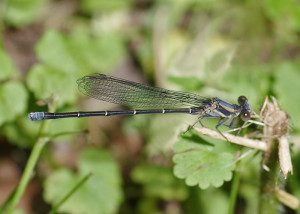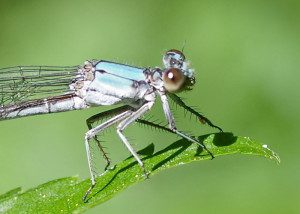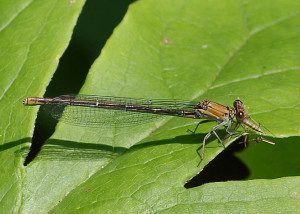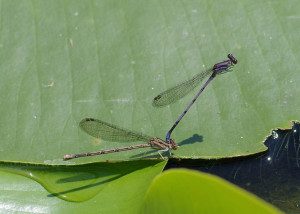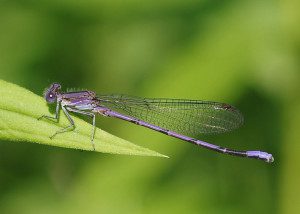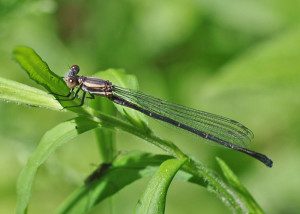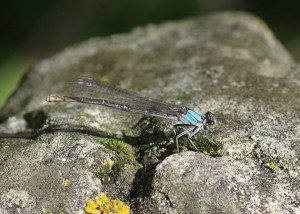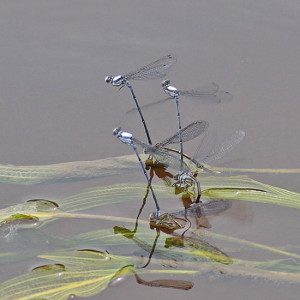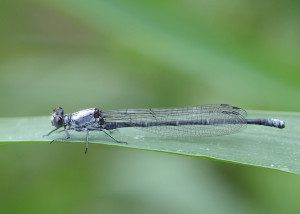Salutations, BugFans,
The BugLady would like to introduce some sprightly damselflies called Dancers, but first, a short commercial message: The Dragonfly Count at Riveredge Nature Center (Newburg-ish, WI) is Saturday, July 23 from 10:00 AM to 3:00 PM. Although (surprisingly) some do keep going after sundown, dragonflies are civilized; you don’t have to get up at the crack of dawn to find them unless you want that magazine cover shot of a dew-covered dragonfly just waking up from a night’s sleep. Come for part or all of the day, and if you want more info or to sign up, contact Mary Holleback at mholleback@riveredge.us or 262-375-2715.
The BugLady has seen four of the six Wisconsin dancers (a Blue-tipped, this spring, was a “lifer”); the two she hasn’t spotted yet (Springwater and Blue-ringed dancers) are uncommon and are expanding their range into the state. See them all at the Wisconsin Odonata Survey website http://wiatri.net/inventory/odonata/.
Dancers are damselflies in the genus Argia, in the pond damsel family Coenagrionidae, in the sub-order Zygoptera (damselflies), in the order Odonata (dragonflies and damselflies – the “toothed ones”). They’re a New World bunch, with the Neotropics being the most species-rich. There are about 120 species so far (35 north of the Rio Grande), and maybe 20 more waiting to be described. Their name comes from their bouncy/jerky, un-bluet-like flight. Says Bob DuBois, in Damselflies of the North Woods, “the most likely meaning for Argia is ‘lazy,’ but no one seems to know how this applies to the group. Argia may have been intended to mean “bright,” from the Greek argos, referring to the coloration of males.”
Size-wise, dancers start where bluets leave off, ranging from about 1 ¼” to about 1 ½.” With their typical blue and black coloration, some bear a strong resemblance to the bluets (others are spectacularly purple or royal blue http://bugguide.net/node/view/321051/bgpage or contrastingly-colored http://bugguide.net/node/view/1058398/bgpage).
Dancers can be told from other damsels because the spines that adorn their legs are twice as long as the spaces between them (those spines help them to snag small insects on the fly). Their wings have short stalks (petioles) that, according to Paulson in Dragonflies and Damselflies of the East, make them strong fliers on their aerial hunts.
Telling dancers from other dancers?? Female dancers are brown/tan, but in some species, females come in a blue color form, too. Blue morph females may look like males; and, males and females in at least one species can switch from one color to another and back; and, dancers may turn darker in color temporarily if they’re chilly. Females of several species can only be distinguished from each other by looking through a hand lens at cross veins in the wings just below the stigma (the colored spot at the tip of the wing).
Although some are found near ponds, dancers are generally associated with slow streams and rivers. Their aquatic naiads http://bugguide.net/node/view/553484 are short and stout and often striped/patterned. Like their Mothers, most are drab brown/olive, but the Varied dancer’s naiad has a purple tinge. Their flattened shape allows them to shelter under rocks and other debris on the bottom of wetlands. They overwinter as naiads, probably in one of their last instars.
Male Dancers may defend loose territories that change daily. Females oviposit in all manner of submerged vegetation, from decaying logs to plant stems and leaves to algae on submerged rocks, and some go way underwater to do so. A female may start out ovipositing with the male protecting his genetic investment by “contact guarding” her (clasping her on the back of her head), but he may detach after a while, leaving her to complete the task alone. Communal ovipositing is not uncommon (more about that later). Although individuals may live only a few weeks as adults, the various species of dancers are on the scene from mid-June through the end of August and beyond.
VARIABLE DANCERS (Argia fumipennis) (“fumipennis” means “smoky-winged”) include three subspecies – the Smoky-winged, the Black, and the Violet dancer. The official name of the species is Variable dancer, but our clear-winged subspecies is often called the Violet dancer. The Smoky-winged http://bugguide.net/node/view/24432/bgimage lives in the East and Southeast; the Black dancer in Florida http://bugguide.net/node/view/422433/bgimage), and the Violet form is found east of the Rockies.
The BugLady sees Violet dancers (Argia fumipennis violacea) more frequently around still waters than the other dancers considered here, but they also like very slow streams with plenty of submerged vegetation. They are small, about 1 ¼,” and they often open and close their wings slowly while perched. Females oviposit into vegetation near just under the surface and don’t submerge.
Violet dancers have an interesting Superpower – they are pretty resistant to water mites. Immature water mites climb onto Odonate naiads while both are under water, and they act like ticks, which can affect the behavior, health, and reproductive success of their hosts. Researchers found that adults of some species, including Variable dancers, are able to fight off mite infestations by “melanotic encapsulation” – that is, their immune system works to clog the mites’stylosome (feeding tube).
These BLUE-TIPPED DANCERS were the BugLady’s reward for being anti-social – she wandered away from a friend’s Open House in June and headed for the river (coincidentally, she had her camera). She had never seen the species before (and they turned out to be a county record – so check your sightings at the Wisconsin Odonata Survey site).
Blue-tipped dancers (Argia tibialis) are found in most of the eastern half of the country, found along sun-dappled streams, sloughs, and rivers (occasionally in still water), but they will use urban streams as readily as those in a forest. They are dark dancers, just under 1 ½” long, that often perch on vegetation near the ground and that also hover over the water. The female oviposits in wet wood, sometimes above the water line – unusual for a dancer – or in floating aquatic plants, with the male in tandem.
Now it gets tricky. Male BLUE-FRONTED DANCERS have, as their name implies, blue fronts – faces and thoraxes. Alas – so do blue-morph female Powdered dancers, (though they lack the blue at the tip of the abdomen). Brown form female Blue-fronted and brown form female Powdered dancers look alike. The dark streak down the top of the abdomen and the location of the pale spots on the top and sides of the females’ 9th (second last) abdominal segment are mentioned in field guides, but those wing veins are still the best bet. Just to make things exciting, both males and females can change from blue to grayish-black over a period of a few days (not age or weather-related), and some individuals were clocked at eight color changes in twelve days.
Blue-fronted dancers (Argia apicalis) live east of the Rockies, into Mexico (with some records in Ontario), where they dance over shady, still water as well as streams and rivers
This is one of our better-studied dancers. What have researchers found? That males visited the shore on about 40% of days during their lifespan, and females on only about 20%, spending the bulk of their time in nearby woods; and that male territorial behavior involves chasing but not fisticuffs. According to researchers George and Juanda Bick, males can recognize both the species and the gender of approaching females, and romance ensues as soon as he grabs her.
POWDERED DANCERS provided the BugLady with one of the most magical “Insect Moments” that she’s ever experienced. She visited Waubedonia Park on the Milwaukee River two years ago and witnessed huge “oviposition aggregations.” Floating leaves in patches of Potamogeton were bristling with tandem pairs of Powdered dancers. Stands of arrowhead were alive with Powdered dancers. Clumps of uprooted vegetation drifted by, bearing more Powdered dancers. She has seen them there since (including yesterday), but not in such numbers.
Oviposition aggregations, which are found even in loosely territorial species like this one, are thought to minimize the threats to ovipositing couples due to predation and due to harassment by unattached males, and to cut down on the time/energy spent by a pair seeking out a suitable spot to oviposit. Researchers Byers and Eason made tiny models of dancers and placed them on likely substrates and found that dancers “visited the ovipositing models first more often than expected by chance, stayed longer there, were more likely to oviposit there, and laid a greater total number of eggs there.” Powdered dancer females may climb down as deep as two feet under water and stay under for more than a half-hour, often accompanied by the male.
Powdered dancers (Argia moesta) get their name from the chalky pruinescence (waxy cells) that develops on mature males (Paulson speculates that pruinosity may allow the Powdered dancer to tolerate the heat more effectively and be active on hot, sunny days). The species name, “moesta,” means “sorrowful,” and may refer to the religious custom of wearing ashes to express sorrow.
All Odonates are carnivores, as naiads and adults. Powdered dancers are among the damselflies that eat other damselflies, though they draw the line at cannibalism.
The BugLady is happiest when the temperatures are between 50 and 70 degrees, but the recent steamy weather is dragonfly weather. Go outside.
Kate Redmond, The BugLady
Bug of the Week archives:
http://www4.uwm.edu/

